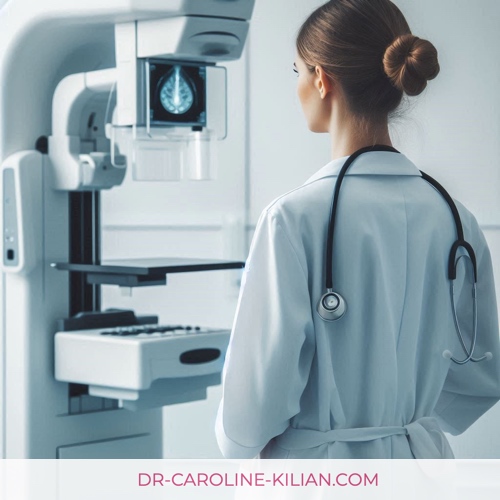Stage 0 and I: Early Detection, Better Outcomes
Early detection of breast cancer significantly enhances treatment success rates and improves patient outcomes. In the initial stages, specifically Stage 0 and I, the cancer is localized, presenting a golden opportunity for medical intervention before the disease progresses. Stage 0, also known as ductal carcinoma in situ (DCIS), indicates the presence of abnormal cells inside the milk ducts, which have not invaded surrounding tissue. While not invasive, DCIS is considered a precursor to invasive breast cancer, necessitating prompt treatment to prevent progression. Stage I breast cancer, a notch higher on the severity scale, is characterized by the presence of a tumor up to 2 centimeters in diameter or cancer cells found in nearby lymph nodes, but not beyond.
The prognosis for patients diagnosed at these nascent stages is typically very favorable, with five-year survival rates approaching nearly 100%. This remarkable statistic underscores the critical importance of regular screening and early diagnosis. Mammography remains the cornerstone of breast cancer detection, capable of identifying tumors that are too small to be felt. Advances in diagnostic imaging and genetic testing have further refined our ability to identify breast cancer in its early stages, offering a lens into an individual's cancer risk profile and tailoring screening protocols to detect abnormalities at the earliest possible juncture.

Treatment modalities for Stage 0 and I breast cancer often involve a combination of surgery—lumpectomy or mastectomy—to remove the tumor, possibly followed by radiation therapy to eliminate residual cancer cells, reducing the risk of recurrence. The choice between these options depends on multiple factors: the size and location of the tumor, patient's age and general health, and personal preferences. Hormone therapy may also be recommended if the cancer cells are hormone receptor-positive, targeting the cancer's ability to use hormones like estrogen and progesterone to grow.
Navigating the journey through breast cancer diagnosis and treatment requires a holistic support system. Health care teams play a pivotal role in providing comprehensive care, ensuring patients understand their diagnosis, the proposed treatment plan, and the implications for their future health and lifestyle. Moreover, the emotional and psychological support from special support groups and counseling services can significantly improve quality of life and foster resilience during and after treatment. Surviving breast cancer starts with early detection, and Stage 0 and I patients embody the hopeful narrative that early intervention can lead to successful management and, ideally, full recovery.
Stages II and III: the Battle Intensifies
As breast cancer progresses to Stage II and Stage III, the disease presents a more complicated challenge to both patients and healthcare providers. Stage II is characterized by the cancer spreading to nearby lymph nodes or by the size of the tumor, which can range from two to five centimeters, or even larger in some cases. Stage III marks further progression, with larger tumors that have deeply invaded neighboring tissues and more lymph nodes. The complexity of treating these stages stems from the cancer's spread beyond the primary site, necessitating a nuanced therapeutic approach that often includes a combination of surgery, chemotherapy, radiation, and sometimes hormone or targeted therapies.
The battle against Stage II and III breast cancer is a multifaceted endeavor. It not only involves aggressive and carefully coordinated treatment plans but also addresses the significant emotional and psychological impacts on the patient. The integration of multidisciplinary teams in managing these stages is crucial, encompassing oncologists, surgeons, radiologists, pathologists, and nursing staff, among others. Their collective expertise can significantly influence the trajectory of treatment and patient prognosis, aiming not only at survival but also at maintaining quality of life.

Moreover, the advancements in medical science have ushered in an era of personalized medicine, where treatments are increasingly tailored to the genetic makeup of the tumor. This approach has shown promise in increasing the efficacy of treatments and reducing side effects. For instance, hormone receptor-positive breast cancer cases can benefit from hormone therapy, whereas HER2-positive tumors may respond well to targeted therapy. Such personalization is pivotal in enhancing the effectiveness of the treatment regimen for Stage II and III breast cancer patients.
Survivorship following a Stage II or III diagnosis requires vigilant follow-up care to monitor for potential recurrence and to manage the long-term side effects of treatment. Rehabilitation services, including physical therapy and psychosocial support, play a vital role in helping survivors navigate the complex journey towards recovery. The intensity of the battle against breast cancer in these stages underscores the importance of early detection and comprehensive care, highlighting the strides made in treatment options that offer hope and improve outcomes for many affected by this formidable disease.
Stage IV: Understanding Metastatic Breast Cancer
Metastatic breast cancer represents the most advanced phase of this disease, where cancer cells have spread beyond the original tumor site to other parts of the body such as the bones, liver, lungs, or brain. This stage, often referred to as stage IV breast cancer, marks a pivotal complexity in the treatment and management of the condition, signifying that the cancer is no longer localized. The biology and behavior of metastatic breast cancer vary significantly, necessitating a personalized approach to treatment. Typically, treatments aim to control the cancer's spread and alleviate symptoms, focusing on improving the quality of life for patients.
The approach to tackling this stage heavily relies on the characteristics of the cancer cells, including hormone receptor status and HER2 protein expression. Targeted therapy, chemotherapy, hormone therapy, and sometimes surgery or radiation therapy, are included in the treatment regimens, designed to target specific pathways or attributes of the cancer cells. Clinical trials also play a crucial role in the management of metastatic breast cancer, offering access to cutting-edge treatments and therapies that aim to extend life and reduce symptoms.

Patient support and palliative care become increasingly central at this stage, addressing the physical, emotional, and psychological effects of the disease. The evolution of treatment strategies has improved survival rates and the quality of life for many patients with metastatic breast cancer, underscoring the importance of ongoing research and clinical trials in the quest for more effective treatments.
Ultimately, the journey through metastatic breast cancer is deeply personal, varying greatly from one individual to another. Advances in medical science continue to unravel the complexities of this stage, offering hope and support to those navigating this challenging phase of their breast cancer journey. Through personalized treatment plans and comprehensive support systems, patients and their families are empowered to confront the realities of metastatic breast cancer with resilience and determination.
Treatment Options Across Different Breast Cancer Stages
Navigating through the diverse treatment modalities available for breast cancer requires understanding the disease's complexity and multifaceted nature. In the initial stages, when the cancer is localized within the breast, surgeons often opt for lumpectomy or mastectomy, sometimes followed by radiation therapy, to minimize recurrence risks. These early interventions, combined with adjuvant therapies such as hormone therapy or chemotherapy, are tailored based on tumor hormone receptor status and genetic markers indicative of the cancer's aggressiveness.
As the stage progresses to II and III, where cancer has spread beyond the breast to nearby lymph nodes or tissues, treatment protocols intensify. Systemic treatments, including chemotherapy, become pivotal in eradicating cancer cells that have ventured beyond the primary tumor site. Her2-positive patients might receive targeted therapy to block the cancer cells' growth-promoting protein. Additionally, advanced radiation techniques and neo-adjuvant therapies are employed to shrink tumors pre-surgery, thus facilitating their removal and potentially improving prognostic outcomes.

Stage IV breast cancer, or metastatic breast cancer, heralds a paradigm shift in treatment goals, pivoting towards prolonging life and palliating symptoms rather than pursuing curative outcomes. This stage sees the incorporation of novel targeted therapies and immunotherapies, aimed at specific genetic mutations within cancer cells to halt their proliferation. Innovations such as CDK4/6 inhibitors, for estrogen receptor-positive metastatic breast cancer, reflect the progression towards personalized medicine, offering hope for extended survival and improved quality of life.
The trajectory of breast cancer treatment underscores the importance of a multidisciplinary approach, seamlessly integrating surgery, radiation, and systemic therapies based on stage-specific requirements. Survivorship plans, tailored to individual patient needs and challenges post-treatment, highlight the continuum of care pivotal in navigating life after diagnosis.
| Stage | Treatment Options |
|---|---|
| 0 & I | Lumpectomy or mastectomy with/without radiation, hormone therapy |
| II & III | Chemotherapy, targeted therapy, radiation, surgery |
| IV | Targeted therapy, immunotherapy, hormone therapy, supportive care |
Survivorship and Support: Life after Diagnosis
Embarking on a journey post-diagnosis, individuals grappling with breast cancer enter a multifaceted phase of survivorship. This critical period accentuates the necessity of a multidisciplinary approach to care, integrating medical, psychological, and social support systems tailored to each survivor's unique needs. Consequently, the adoption of a survivorship care plan—a comprehensive document developed by healthcare providers—plays an indispensable role. It outlines follow-up treatments, potential long-term side effects, and strategies for health monitoring, equipping survivors with the knowledge to navigate their recovery path.
The transition from active treatment to survivorship marks a pivotal moment, often accompanied by a plethora of emotions and uncertainties. Addressing the psychosocial aspects of recovery becomes as imperative as the physical healing itself. Support groups and counseling services emerge as vital resources, offering a platform for individuals to share experiences, coping strategies, and foster a sense of community. Wellness and rehabilitation programs, focusing on nutrition, physical activity, and stress management, further contribute to improving quality of life and reducing the risk of recurrence.

Moreover, the exploration of survivorship extends into the realm of ongoing research, aiming to elucidate long-term outcomes and optimize post-treatment care. Scientific investigations delve into the effects of various therapies, surveillance techniques, and lifestyle factors, with the goal of enhancing survivorship protocols and support mechanisms. Through the continual assimilation of evidence-based practices, healthcare providers strive to stay at the forefront of advancements, ensuring that survivors receive the most effective and personalized care possible.
In conclusion, the trajectory of survivorship embodies a journey of resilience and renewal, underscored by comprehensive support and cutting-edge care. As individuals navigate life after diagnosis, the collective endeavor of medical professionals, researchers, and supportive networks plays a crucial role in fostering a holistic recovery. Emphasizing the importance of survivorship care plans, psychosocial support, and ongoing research, this journey reflects a concerted effort to transcend the challenges of breast cancer, affirming life beyond diagnosis.







